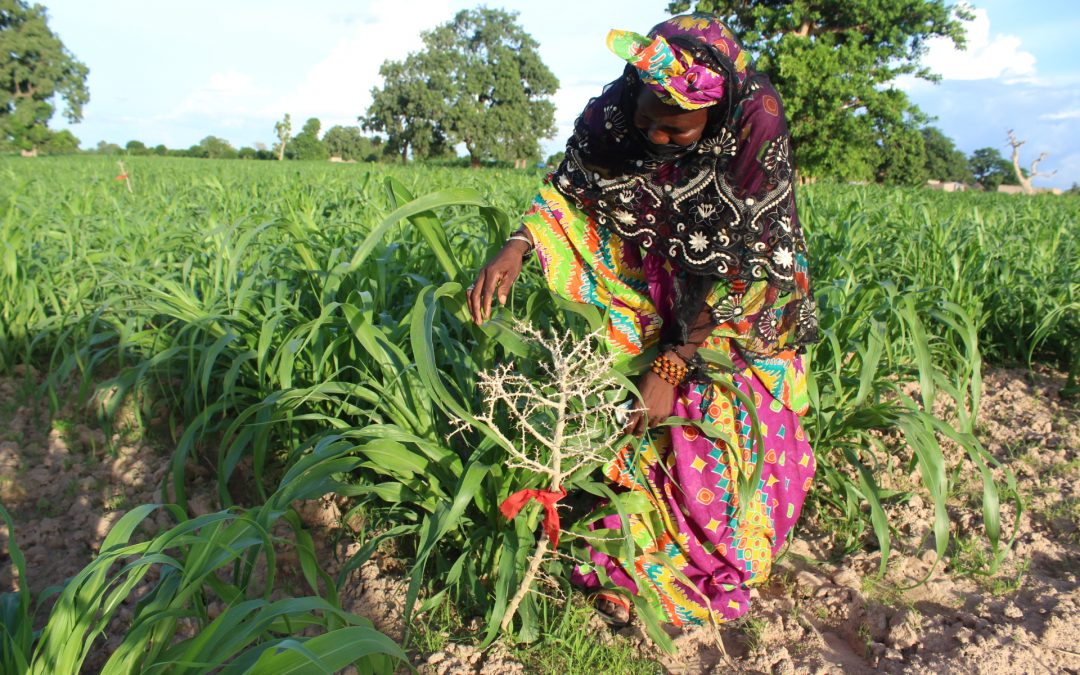By May Muthuri and Anna Daba
Radio programs are spreading the good work of the Regreening Africa project in Senegal.
‘Good evening, dear listeners, this is your friendly team from the Regreening Africa Project on the number one talk show.’
This is a familiar phrase to the residents of Fatick, Kaffrine and Kaolack regions in Senegal, where the Regreening Africa project is implementing activities. Because of COVID-19, adjusting to the ‘new normal’ has required ingenious thinking. Community radio remains a simple and reliable means of reaching populations to ensure continuity of services.

A farmer, technical agent from Ministry of Forestry, and a project facilitator during a radio show on Alfayda Station. Photo: Abdoulaye Sene, World Vision Senegal
This ‘old school’ medium with a presenter in a modest room housing a wooden table and chair, two microphones and protection equipment against COVID-19 is proving to be essential for this European Union-funded project that aims to expand the scale of previous efforts while also encouraging adoption of regreening techniques by more farmers. Implemented by World Vision Senegal with technical support from World Agroforestry (ICRAF), the project targets restoration of 160,000 hectares to improve the resilience of 80,000 households in the above-named regions.
Thanks to the flexibility and efficiency of being spoken in ‘indigenous’ dialects and powered through portable devices such as phones that double as torches at night, community radio is curating space for discussion on the airwaves to build back better.
To date, more than 15,000 people have listened to one-hour broadcasts on 12 community radio stations in Fatick, Kaolack and Kaffrine. With messages encompassing the importance of adopting sustainable restoration practices, teams from World Vision Senegal in partnership with the regional service of Water and Forestry and leading farmers have for the past three months sung the rehabilitation message in French, Wolof and Serere languages.
The practices promoted over the air include planting and caring for trees, farmer-managed natural regeneration (FMNR), soil-restoration techniques like mulching, and establishment and management of tree nurseries, which are in special ways transforming the lives and livelihoods of farmers trained by Regreening Africa.
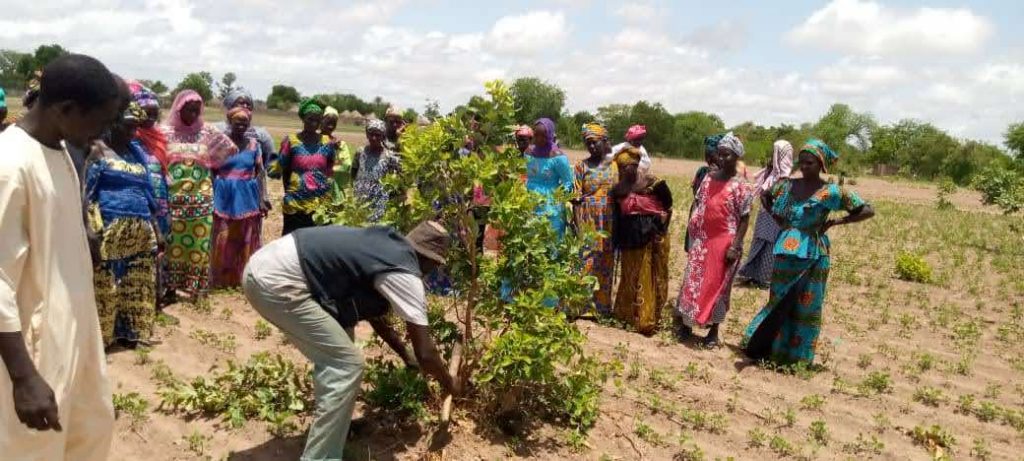
Farmer training on FMNR practice. Photo: Samba Ndao, World Vision Senegal
It is now a tradition in most Kaolack households between 5pm and 6pm on Mondays to sit with family or friends ready to receive great ideas that can not only transform the level of soil fertility, increase crop yields and improve nutrition but also diversify income-generating avenues.
‘I didn’t have the chance to go to school,’ said Modou, a leading farmer, ‘but I’m aware of the level of environmental degradation. With my 2-acre farm, I know I can change the narrative for my children by enrolling them in school. Therefore, anything that can point me towards achieving this goal, I take it seriously.’
Even the youngest in each household knows better than to interfere with the ‘life changing’ transmissions from the radio station.
So how does it all play out? Staff from World Vision Senegal take a community-centered approach by liaising with journalists and leading farmers in each region. This way, assessments of topics that are at the heart of many farmers or pastoralists’ issues are expounded and then tied to what the project does in order to understand what would work for each area, for whom, for what purpose and the likelihood of listeners following the advice. This is backed-up by ‘how to’ sessions of roughly 30 minutes, where listeners are guided on the techniques to nurture trees from seedlings to maturity, the right equipment to use and booklets to read or persons to be in touch with should they need further guidance. At the end, 30 minutes are spared for call-ins from listeners.
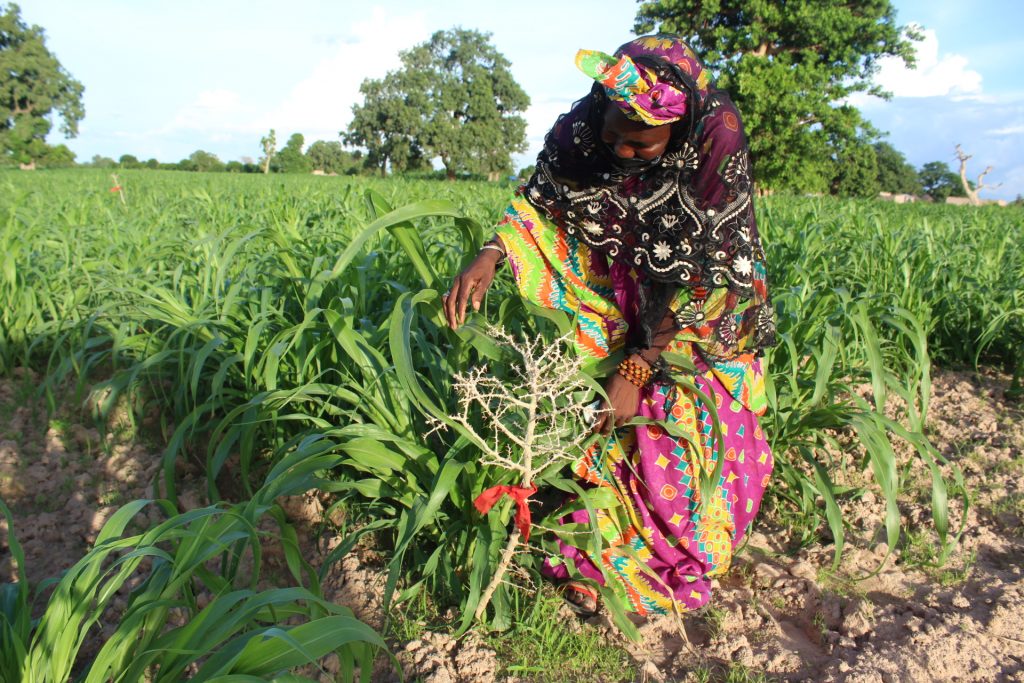
A farmer from Kawitiane village explaining the steps of FMNR during the projects’ joint reflection and learning mission. Photo: Joseph Bidiar,World Vision Seengal
It has come out clearly that the selection of tree species is not just based on the price tag of seedlings, ornamental tastes or as an investment for hard times. Moreover, it’s evident that owning trees on one’s farm shouldn’t be considered a luxury but a necessity. Selection is about choosing species suitable for specific agro-ecological niches, the health of soils (based on assessments through the Land Degradation Surveillance Framework), monitoring exercises that reveal the compatibility of other vegetation in relation to the trees, and finally, value chains that can carry the products to markets.
Through this process, there is an evident increase in products such as fodder for livestock hence milk and meat, and juicy fruits. Incomes are diversified through sale of excess yields, timber and value added to tree-based products, such as baobab fruit powder.
There’s no ‘magic bullet’ to restoration but clearly these fragments of extraordinary impact narrated by the farmers are indications that the ‘old school’ medium is heading in the right direction.
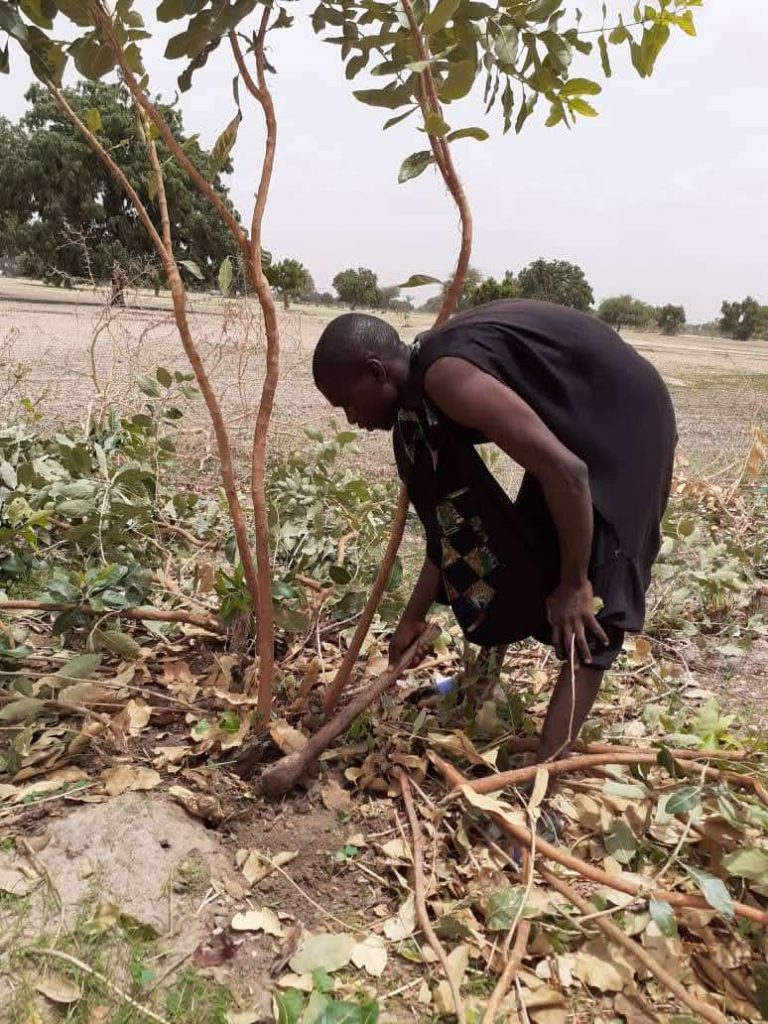
A farmer from Keur socé village in Kaolack region thinning Combretum glutinosum tree on his FMNR farm. Photo: Gorgui Sene, animator Keur Socé commune
‘I dismissed tree stumps left in the ground,’ said Doudou, a leading farmer in Fatick, during a phone call with the radio program. ‘My thinking has changed completely as I now know how to manage young shoots, shielding them from my livestock when grazing, so that they grow and serve various purposes for me later on. After training on FMNR, I have nurtured Guiera senegalensis that has allowed my wife to have wood for use in the kitchen unlike before when she would walk for long to fetch firewood. Here in Fatick, we have a strong presence of guiera, so I invite my friends to take-up FMNR by valuing such indigenous species. I am grateful to our project animators for initiating this and enlightening more farmers on the role they can play in not only bettering themselves as farmers but improving immediate environs now that we know how our actions have been destroying it.’
Local leaders are also better informed of their role in encouraging the adoption of FMNR. As a new ambassador of the approach, Ndiaye, deputy mayor of Segregatta commune in Kaffrine, said that, ‘My commune has to be enlisted in the Regreening Africa project. I bear witness to the great transformation this project has brought to other communes like Diamal or Ndiognick and because of that I have allocated a budget line specifically for environmental activities, such as restoration and enrichment of community forests. These will be accompanied by the approaches implemented by the Regreening Africa project.’
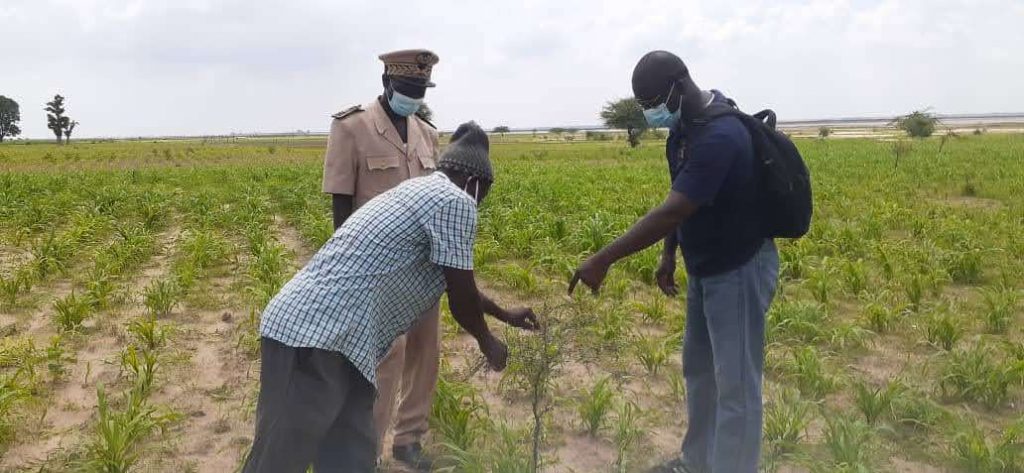
Sub-prefect of Ndiedieng listening attentively to the explanations of the farmer and the Manager of the Livelihoods Program ar World Vision Senegal, on FMNR techniques. Photo: Joseph Bidiar, World Vision Senegal
The mayor also noted his plans to involve women by providing them with improved cooking stoves and engaging them in the restoration initiatives.
Radio journalists with a keen interest in environment have caught the restoration buzz. One manager, Fall, from Guinguinéo Radio committed to mobilising his team to broadcasting tree planting and FMNR techniques with guidance from World Vision Senegal’s technical staff.
‘My plan is to use this approach to ensure communities master the restoration approaches promoted by Regreening Africa,’ he said. ‘This will be my contribution to environmental protection.’
Coming good on his promise, Fall has since aired the project’s official COVID-19 and restoration messages of his own volition, as well as posting them on the station’s Facebook page, to reach audiences in remote areas.
Project staff doing field visits attest to reduced slash-and-burn practices that have been common as farmers prepared for planting. Queries about techniques for identifying tree species and additional training on the approaches promoted by the project on air have been on the rise and these are being addressed by project facilitators in each region through phone calls, WhatsApp groups and one-on-one meetings with farmers while adhering to safety regulations issued by the Government and Ministry of Health.
‘After the radio program in Guinguinéo,’ said Sidy Diallo, the project’s focal point in the Guinguinéo zone, ‘some people contacted me from Dakar and neighbouring communes to let me know that they followed the program from Facebook and that they just wanted to encourage us for the awareness work that we are doing in the field.’
Moreover, the project team is also enlightened on arising challenges as well as indigenous innovations that communities use to circumvent climate change, increase adoption rates and have more impact overall.
About Regreening Africa
Regreening Africa is an ambitious five-year project that seeks to reverse land degradation among 500,000 households, and across 1 million hectares in eight countries in Sub-Saharan Africa. By incorporating trees into croplands, communal lands and pastoral areas, regreening efforts make it possible to reclaim Africa’s degraded landscapes.
This story was produced with the financial support of the European Union. Its contents are the sole responsibility of Regreening Africa and do not necessarily reflect the views of the European Union.

